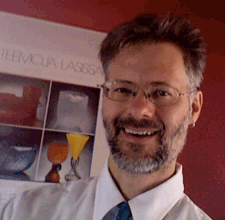Pilgrim Reindeer in Pisa, 1348
a free multimedia novel by
Thomas A. DuBois, University of Wisconsin-Madison
 |
Pilgrim Reindeer in Pisa, 1348 a free multimedia novel by Thomas A. DuBois, University of Wisconsin-Madison |
|
|
|
1. Part I Setting Out 4. The First Steps [July 6, 1347]
In this chapter, we finally get to see who Sieidi really is, and I meant it to be kind of a jolt to suddenly see this sacred being from an outsider's disbelieving perspective. We also see the limitations of Sálle's linguistic gifts, as he tries to puzzle out what the friar is talking about. I hoped to suggest what a daunting challenge it was to try to convey complex theological concepts when one knows hardly anything of another person's language and culture. I also wanted to avoid demonizing (sorry for the term) the missionary, as that narrative has been played over and over again and is thoroughly threadbare as a literary device at this point. Yes, missionaries were sometimes out of touch with the cultures they met with, and yes, they sometimes damaged native systems of worship and sacrality with their new ideas, but there were many, like the friar here, who meant well. They weren't all just really nasty sociopaths bent on destroying other cultures. Truth be told, I think the real ravaging of indigenous cultures came from political powers who used religion as a device for subjugating conquered populaces: missionaries, or forced religious adherence, were often simply tools in that larger process of undermining and discrediting local authorities so as to better consolidate power over a district or nation. At any rate, we see Sálle taking in the stranger's new ideas and fitting them into his own belief system: something that clearly happened a lot in the Christianization of northern Europe.
Sálle's attempt to teach his companion how to say "good friend" in Sámi--buore ustit--is important in the novel, as Sálle will eventually come to have a friend whose name means "good friend."